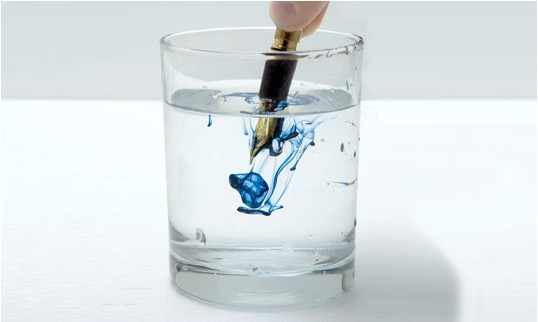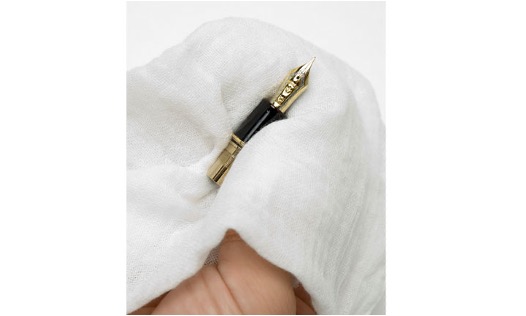Here are some tips on how to care for your precious fountain pens so that they can be used with pleasure for many years to come.
The most common reason for a fountain pen to stop writing is that the ink hardens inside the pen, making it difficult to flow.
To prevent this, it’s best to use your fountain pen every day. Writing a little each day keeps the ink flowing smoothly.
Fountain pens should be cleaned regularly, ideally every two to three months, even if they are used frequently.
Cleaning is especially important in the following cases:
→ Paper dust or hardened ink may be causing the issue.
→ Remember to refill with fresh ink before using it again
→ Old ink may have hardened inside the nib.
Different ink refilling styles require different cleaning methods. Here’s what you need and how to do it.
Materials Needed: Fountain pen to be cleaned, cup of water, soft cloth or tissue paper.
Note: Avoid using wet wipes, cloths, or chemicals containing alcohol to clean the body or lid, as this can damage the resin.
Note: If a fountain pen with a wooden barrel (KOP BRIER Fountain Pen) is exposed to water, it may expand and crack.

1. Remove the cap and take off the barrel.

2. Pull out the used ink cartridge from the gripping section and dispose of it properly.

3. Place the gripping section in a glass of water gently.

4. Let the entire gripping section soak in water overnight.
Note: For transparent or skeleton-colored nibs, avoid soaking to prevent ink pigmentation. Instead, rinse only the nib with water.

5. Rinse the gripping section with tap water.

6. Thoroughly wipe it dry with a soft cloth or tissue paper.
The cleaning process is complete when no dark-colored ink adheres to the cloth or tissue paper.

1. Remove the cap and take off the barrel.

2. Dip the nib into a glass of water and turn the converter’s knob to draw in water, just as you would with ink.

3. Turn the converter’s knob the other way to expel the drawn-in water. Repeat this process of drawing in and expelling water 5-6 times.

4. Remove the converter from the nib, replace the water in the glass, and immerse the entire nib section in water overnight.
Note: For transparent or skeleton-colored nibs, avoid soaking to prevent ink pigmentation. Instead, rinse only the nib with water.

5. Rinse the nib section with tap water.

6. Thoroughly wipe it dry with a soft cloth or tissue paper.
The cleaning process is complete when no dark-colored ink adheres to the cloth or tissue paper.

1. Place a piece of tissue paper or a similar material underneath to prevent ink from spilling and staining.
Turn the barrel end in the direction of the arrow to expel any remaining ink from the pen body.

2. Dip the nib into a glass of water and turn the barrel end to draw in water, just as you would with ink.

3. Turn the barrel end in the opposite direction to expel the drawn-in water. Repeat this process of drawing in and expelling water multiple times.
Note: Water droplets may accumulate in the ink tank window, but this is not a problem during product use.
Note: Please be aware that if the product is submerged in water beyond the gripping section ring, water may enter the inside of the gripping section(especially in the case of the transparent original product, it is easily visible).
Note: Avoid soaking the entire body in water, as water can enter the body through the gap in the tailstock.

4. Wipe the pen dry with a soft cloth or tissue paper.
The cleaning process is complete when no dark-colored ink adheres to the cloth or tissue paper.
Fountain pens that use cartridge ink or converters can be cleaned more quickly with the Fountain Pen Maintenance Kit.
For instructions on how to clean your fountain pen using the Fountain Pen Maintenance Kit, please click the following link.